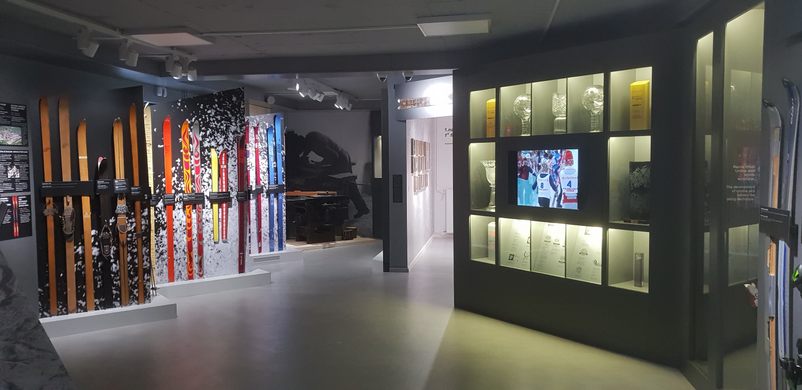Alpine Ski Museum
This cutting edge museum details the history of skiing, from its ancient origins to its status as a sport.
For fans of alpine skiing, there is no greater name than Ingemar Stenmark. The Swede racked up 86 World Cup wins, and is universally acknowledged as the sport’s all-time great. He’s a fitting figurehead to open the new Alpine Ski Museum, which he did in June 2018.
The Ski Museum is located in the town of Begunje na Gorenskem, Slovenia, a short drive from the famously photogenic Lake Bled and other charming localities. Tiny Begunje is famous for a handful of big things: a pair of castles (Ravensburg and Kamen), the home and museum of polka legend Slavko Avsenik and the world-renowned ski manufacturer, Elan.
The Alpine Ski Museum is a branded affair, organized by Elan and housed adjacent to its outlet store. While the skis featured are from the home brand, they’re the very skis that won famous competitions. Elan is best-known for having invented carving skis in 1991, which are today the universal standard for recreational skiers, but in the museum, the history of skiing is still objectively presented, complete with interactive displays. In the museum, you’ll find a mechanical ski and snowboard simulator (think of skis and a snowboard on a giant metal spring), a digital slalom simulator, and the material components of skis laid out so you can put them together and make like a master ski-smith.
Elan was founded in 1945 to provide skis for the Partisans in Yugoslavia, so they could better fight the occupying Nazis, but the history lessons offered in the museum look back to 10,000 BC, the approximate date when a cave painting of a hunter on skis was carved into the rock of the Altai Mountains, along the border between China and Mongolia. A similar carving from circa-3500 BC was found on Rodoy Island, Norway, demonstrating that skis were used to hunt wherever humans lived in snowy conditions. Wooden components of what experts consider proto-skis have been found at Vyg Lake in Russia dating to between 7000 and 5000 BC. It seems that strapping wood to your feet to better glide over snow has been an idea employed for as long as you can imagine.
Alpine skiing as a sport was developed by the Austrian, Mathias Zdarsky, in the 1890s, but most skis were just straight, smooth wooden planks, sometimes curled up at the front, and with leather straps to hold your feet in place. The biggest technological revolution in skiing happened to come in 1991, the year of Slovenia’s independence, when Elan created the Sidecut Extreme (SCX) ski, based on the principle that carving (making smooth, sharp turns) is easier on a ski that has more of an hourglass shape than a stiff, straight plank. This shape, referred to more generally as “carving skis,” has become the industry standard from that point on.
Know Before You Go
The museum is open Tuesday through Sunday from 10 a.m. to 6 p.m.



















Follow us on Twitter to get the latest on the world's hidden wonders.
Like us on Facebook to get the latest on the world's hidden wonders.
Follow us on Twitter Like us on Facebook